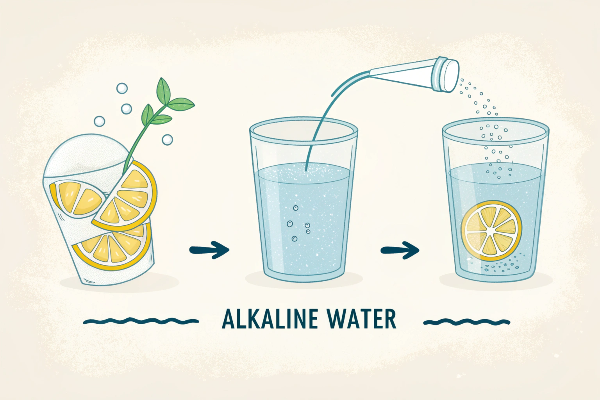Feeling lost in the complex world of metal extraction? Ever wonder how we get pure metals like copper from raw ore?
Electrowinning is an electrochemical process used to recover metals from solutions. It involves passing an electric current through a solution containing dissolved metals, causing the metal ions to deposit onto a cathode.
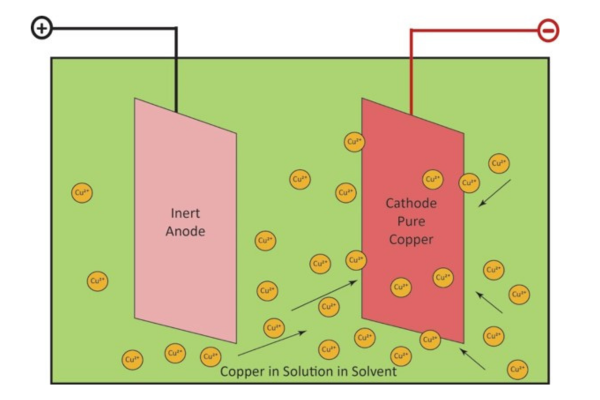
But that’s just scratching the surface. Let’s explore this process in detail, from its inner workings to its real-world impact. I’ll break it all down!
How Does Electrowinning Actually Work Step-by-Step?
Want a peek behind the curtain? Thinking about the practical steps of setting up an electrowinning process, not just the theory?
The basic steps are: leaching the raw material, purifying the solution, setting the electrolytic cell, performing electrodeposition, and then scraping off the metal. Typical settings include voltage (2-3V), temperature(35-55°C) and pH (1.5-2).
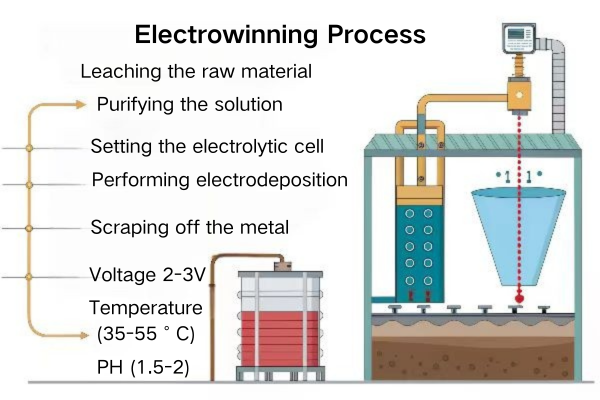
Diving Deep into the Electrowinning Process
Let’s go deeper. To truly understand the practicality, we need to look beyond just basic definitions. Let’s explore the operational details, from the lab to a full-scale plant.
-
Raw Material Leaching: This is where it all starts. We dissolve the metal-containing ore, often using an acid solution. Think of it like making a "metal soup." For example, copper oxide ore reacts with sulfuric acid.
-
Electrolyte Purification: The "soup" is often full of impurities. We need to filter out these unwanted ions, like iron or manganese, to ensure a pure metal product. It’s like cleaning the ingredients before cooking.
-
Electrolytic Cell Setup1: This is where the magic happens. We have two electrodes: a cathode (usually stainless steel or titanium) and an anode (often a lead alloy). These are immersed in our purified "metal soup."
-
Electrodeposition2: We apply a direct current. Metal ions in the solution are attracted to the cathode, where they gain electrons and deposit as solid metal. This typically requires current densities between 200-450 A/m².
-
Metal Harvesting3: After a period (usually 1-7 days), the cathode is removed. The deposited metal is then scraped off. It’s like harvesting a crop!
Typical Technical Parameters (Copper Example)
| Parameter | Typical Range |
|---|---|
| Voltage | 2-3 V |
| Temperature | 35-55°C |
| pH | 1.5-2 |
| Current Density | 200-450 A/m² |
These numbers give you a practical idea of the conditions inside a typical copper electrowinning cell. They can vary, but this gives you a starting point.
What Industries Rely Most on Electrowinning?
Unsure if electrowinning4 is the right fit for your industry? Are you a startup exploring options and need to see where this tech shines?
Mining is the biggest user, with copper, zinc, and nickel making up 75% of global electrowinning. Electronic waste recycling is another key area, recovering valuable metals like gold and silver, often boosting profits by 30%.
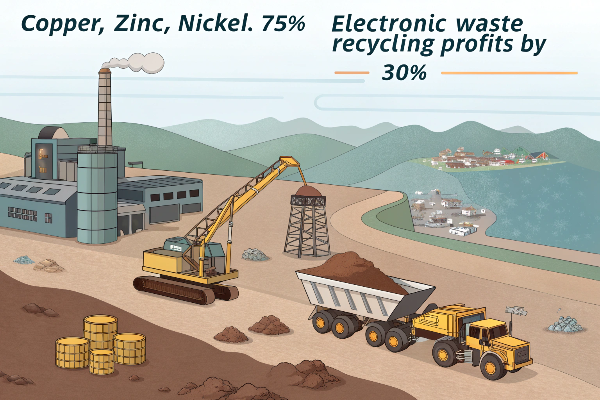
Deep Dive: Industrial Applications
Let’s get specific. Knowing the broad industries is one thing, but seeing real-world examples helps solidify the understanding.
-
Mining: This is the king of electrowinning. It’s used extensively for copper, zinc, and nickel production. Think huge, open-pit mines. For instance, Chile’s Escondida copper mine, one of the world’s largest, produces over 1 million tons of electrowon copper annually, with costs reportedly 18% lower than traditional smelting methods.
-
Electronic Waste Recycling5: This is a growing application. Circuit boards and electronic components contain precious metals like gold, silver, and palladium. Electrowinning offers an efficient way to recover these, turning waste into profit. It’s becoming economically vital, especially with rising resource scarcity.
-
Lithium Battery Recycling6: As electric vehicles boom, so does the need to recycle their batteries. Electrowinning is crucial for recovering valuable materials like cobalt and lithium. Costs can be as low as $5/kg for extracted materials, making it economically attractive.
Case Studies: Data-Driven Success
It is important to look at real data. Chile’s Escondida mine7 (mentioned above) isn’t just a random example. It showcases how electrowinning scales to massive industrial operations and offers significant cost savings8. This provides a compelling case for potential investors or companies considering the technology.
Can Small Businesses Use Electrowinning Affordably?
Worried about the cost? Thinking electrowinning is only for giant corporations? Need a scalable solution for your smaller operation?
Yes, small businesses can use electrowinning9. Options range from small, laboratory-scale setups costing $5,000-$15,000 (for daily outputs under 10kg) to modular systems for regional recycling centers10 (around $100,000-$500,000 investment).
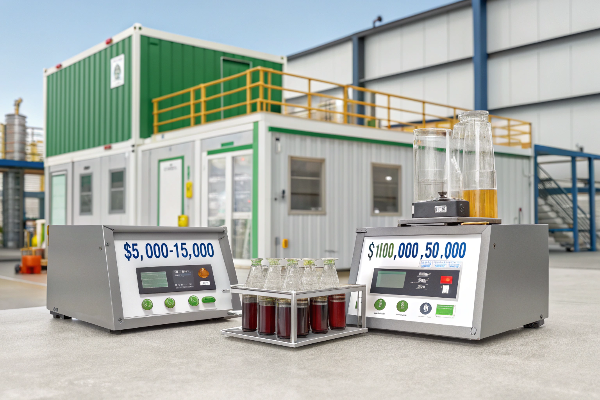
Deep Dive: Cost-Effective Solutions for SMEs
Let’s break down the costs. It’s not a one-size-fits-all situation.
| Scale | Investment Cost | Applicable Scenarios |
|---|---|---|
| Laboratory Grade | $5,000 – $15,000 | Experimental testing, small-scale research (daily output <10kg) |
| Medium Modular | $100,000 – $500,000 | Regional recycling centers, small mines (daily processing ~1 ton of ore) |
| Industrial Grade | $2,000,000+ | Large-scale mining operations (daily output >50 tons) |
Energy-Saving Tips
Electrowinning can be energy-intensive11. However, techniques like pulse current technology can reduce power consumption by up to 30%. This is crucial for smaller businesses looking to minimize operating costs. Think of it as a way to make the process "leaner" and more affordable.
What are the Environmental Risks of Electrowinning?
Balancing production with environmental responsibility? Concerned about acid mist, waste disposal, and overall sustainability?
The main risks are acid electrolyte leakage12, acid mist emissions13 (especially sulfuric acid), and high energy consumption14. However, with proper mitigation, like using double-layered containment and alkali spray systems, risks can be minimized.
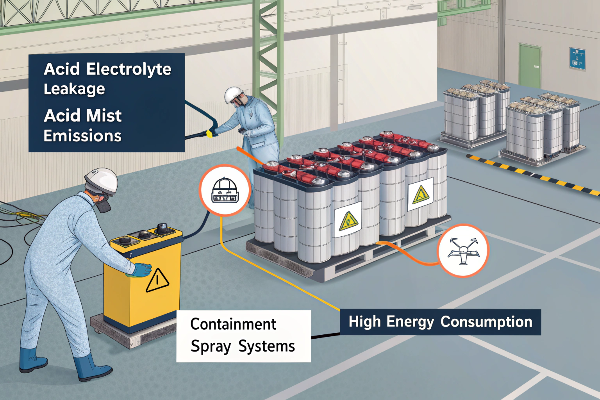
Deep Dive: Addressing Environmental Concerns
Let’s tackle these concerns head-on. It’s not just about identifying the problems; it’s about finding practical solutions.
-
Acid Electrolyte Leakage: This is a serious risk. Spilled electrolyte can contaminate soil and water. The solution? Double-layer High-Density Polyethylene (HDPE) impermeable pools. This provides a robust barrier against leaks.
-
Acid Mist (Sulfuric Acid Mist): During operation, a fine mist of sulfuric acid can be released. This is a health and environmental hazard. The solution? Closed electrolytic cells combined with an alkali solution spray system. These systems can achieve capture efficiencies exceeding 95%.
-
High Energy Consumption: Electrowinning can be power-hungry. The solution? Integrating renewable energy sources. For example, a gold mine in South Africa has achieved 60% green electricity coverage using solar power.
Proactive, Not Reactive
The key here is proactive management. It’s not about if problems will occur, but how to prevent them. This approach aligns with modern Environmental, Social, and Governance (ESG) standards, which are increasingly important for businesses.
What are the Pros and Cons vs Other Metal Extraction Methods?
Need to make a technical decision? Comparing electrowinning to other methods like pyrometallurgy15 (smelting) and hydrometallurgy16?
Electrowinning has lower energy consumption than combined hydrometallurgical process, but higher than smelting process. And the initial investment is relatively lower.
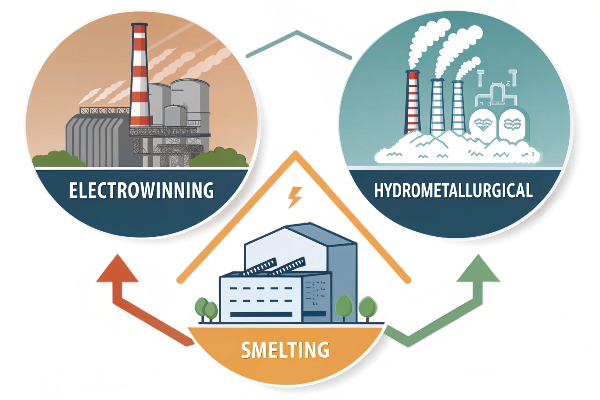
Deep Dive: A Comparative Analysis (Copper Example)
Let’s put this into a clear comparison. We’ll use copper as our example, as it’s a common metal extracted using all these methods.
| Indicator | Electrowinning | Pyrometallurgy (Smelting) | Hydrometallurgy + Electrodeposition |
|---|---|---|---|
| Raw Material Grade Needs | Low (can work with 0.5 g/L solutions) | High (needs >20% Cu ore) | Medium (1-5% Cu ore) |
| Energy Consumption | 2500-3000 kWh/ton copper | 1800-2200 kWh/ton copper | 4000+ kWh/ton copper |
| Carbon Emissions | Medium | High | Low (if using green electricity) |
| Initial Investment | $2M/10,000 tons capacity | $4M/10,000 tons capacity | $3.5M/10,000 tons capacity |
Making the Right Choice
The "best" method depends on your specific situation. Electrowinning excels with lower-grade ores and offers environmental advantages if coupled with renewable energy. Smelting is energy-efficient for high-grade ores but has higher emissions.
Conclusion
Electrowinning isn’t just a niche process. It’s a versatile technique with applications spanning from small-scale recycling to massive mining operations, playing a growing role in a resource-conscious world.
-
Understanding the setup of an electrolytic cell is crucial for successful electrowinning. Explore this link for detailed insights. ↩
-
Electrodeposition is a key step in electrowinning. Learn more about its mechanisms and importance through this resource. ↩
-
Metal harvesting is the final step in electrowinning. Discover various techniques and best practices for efficient metal recovery. ↩
-
Explore this link to understand the fundamentals of electrowinning and its diverse applications across industries. ↩
-
Discover how electrowinning transforms electronic waste into valuable resources, enhancing sustainability and profitability. ↩
-
Learn about the critical role of electrowinning in recycling lithium batteries, crucial for the electric vehicle industry. ↩
-
Exploring the Escondida mine will provide insights into its significance in the mining industry and its operational success. ↩
-
Discovering how electrowinning leads to cost savings can inform investment decisions and operational strategies. ↩
-
Explore how small businesses can leverage electrowinning technology to enhance their operations affordably. ↩
-
Discover how modular systems can provide scalable solutions for recycling centers, making electrowinning accessible for smaller operations. ↩
-
Learn about energy-saving techniques that can make electrowinning more efficient and cost-effective for small businesses. ↩
-
Preventing acid electrolyte leakage is vital for environmental safety. Discover effective strategies and solutions in this resource. ↩
-
Understanding acid mist emissions is crucial for mitigating health and environmental risks. Explore this link for in-depth insights. ↩
-
Addressing high energy consumption is key to sustainable practices. Learn about innovative solutions and renewable energy integration here. ↩
-
Learn about pyrometallurgy’s efficiency and environmental impact to make informed decisions in metal extraction. ↩
-
Discover how hydrometallurgy compares to other methods and its suitability for different ore grades. ↩



